The motorsport championship for electric cars arrives in Monte Carlo with a remarkable host of production and broadcast innovations
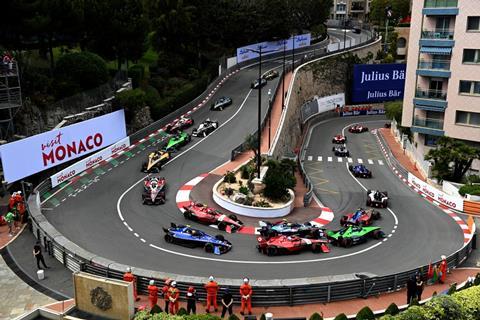
Formula E’s E-Prix in Monaco on 6 May saw an impressive catalogue of innovations and adaptations to the sport itself arrive on the streets of Monte Carlo, ushering in a new look and feel for the nine-year old championship.
Press and guests were invited from around the world (in particular from Portland, Oregon, where Formula E makes its debut later this month) with Formula E laying on a host of events to rival the scale and grandeur of press events put on by its gas-guzzling counterpart, Formula 1.
And while comparisons to Formula 1 are inevitable – and frequently made by journalists and Formula E itself across the race weekend – Formula E is keen for conversations not to continually boil down to comparisons to how things are done in Formula 1.
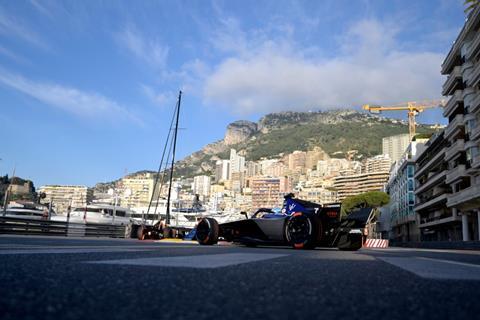
Formula E’s hospitality was certainly designed to impress, although some work was required to understand how you should dress to impress – Formula E’s invite included dress codes for each of the events it put on, which included Monaco fancy (I kid you not), Italian/French business casual and Beach Club casual.
Armed with a hastily assembled new wardrobe, I headed out to Monaco where for the weekend, the focus was on trying not to feel too much imposter syndrome while immersed in the lifestyles of the rich and famous, with a mission to find out exactly what goes into producing and broadcasting Formula E from the streets of the city.
On the agenda of things to do was experience a ‘hot lap’ of the Monaco street circuit in one of the safety cars, slamming around the course at what felt like breakneck speed – an activity we had to sign a disclaimer to take part in, which I didn’t read in great detail for fear of feeling even more fear during the lap.
This was still only a fraction of the speed the Formula E drivers would be booting it around the same streets less than an hour later. The new Gen-3 cars, which Formula E describe as the “World’s first net-zero carbon race car” have an increased maximum speed (up to 200mph) and reach 100km/h in 2.8 seconds. It’s 75% more powerful and has a top speed that’s 95km/h faster than the first generation of Formula E vehicles.

Massive changes
Before my lap of the circuit, I caught up with Formula E broadcast and content director Tim Glass and technology director Eric Ernst in the fan zone area next to the harbour, with the sun beating down on a rarefied collection of ultra-expensive yachts.
The weather and generally relaxed pace of life in Monaco appear to have rubbed off on the pair, who are in a pretty tranquil mood. This is in contrast to how you might imagine they would feel with the responsibility of ensuring a long list of very recent enhancements to overhaul coverage of Formula E races all hit the mark in Monaco.
“This year it’s been a massive step because we rebuilt the entire TV production from the ground up. We’re probably running the biggest and most modern remote production of a sporting series of this size,” explains Ernst.
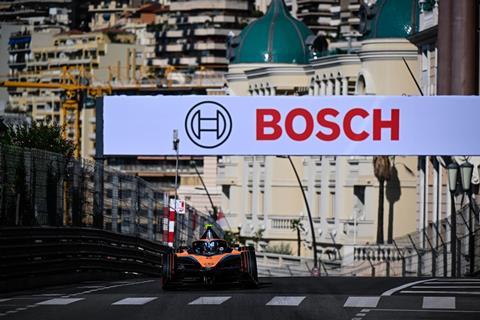
The remote production sees 90+ signals being sent live from the track to Gravity Media in Westworks London over internet lines. At Westworks, there’s a director that makes the live programme from the 24-camera track feed created on location, together with an assortment of special cameras, feeds from helicopter cams, kerb cameras, onboard cameras, and so on. They cut the live show in London, and it is immediately transferred back to the race location.
The audio and graphics are also taken care of remotely at Westworks. The content travels from Monaco to London and back again in less than two seconds and is shown on the big screens around the track.
The low latency is made possible through Tata Communication internet lines with some “very sophisticated encoding. Everything is top-tier equipment – we built it from the ground up so there’s no legacy to have to worry about,” says Ernst.
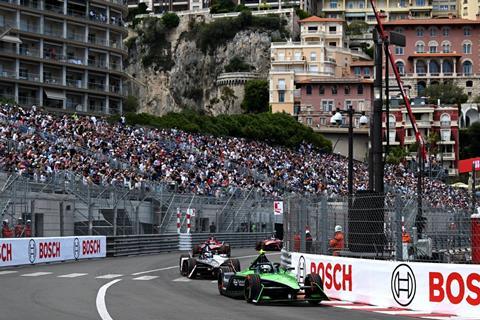
The key driver for the remote production model is to add efficiencies, to make production more sustainable, and to cater to the practical limitations of space and access in hosting races in city centres.
“We reduced the TV compound footprint by 50% so about 50 more people can stay in London and work from Westworks and don’t have to get on a plane and come here,” says Ernst. “It means we can build fewer cabins, install less air conditioning, require less food, and we’re taking less power from the grid here. And obviously, the freight has gone down massively – by around 40% – because we’re not building galleries here anymore. There’s one backup gallery here that does the track feed and that’s it.”
Ernst is also keen to stress that the remote production model for Formula E faces challenges not necessarily faced by other sports. He says: “It is not just remote production like everyone does it – it’s not a football stadium with eight cameras, we’re running 120 sources, you know, and we’re doing it from a parking lot.”
As well as sustainability and cost and practical efficiencies, the remote production model has enhanced creativity, believes Ernst. “We’ve found, by having two directors work on different parts of the program, makes a much better output.”
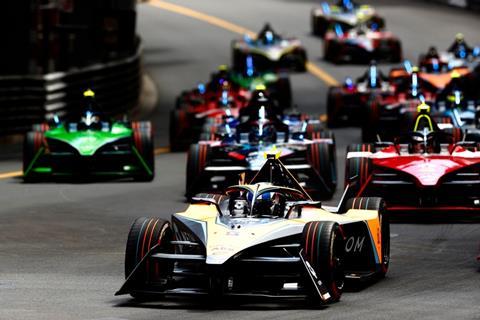
Onboard camera innovations
Another big factor in enhancing the live coverage of the race is a new camera system that’s been created for the Gen-3 Formula E cars. Each car now has 10 cameras that are constantly recording what’s happening on the vehicle during the race. There are also 10 audio channels from every car, as every camera has a microphone.
“At the back of each car there’s a ring camera and there are two cameras in the wings,” says Ernst. “Then there’s a camera looking back, then in each mirror there’s a camera, looking over the wheel at the driver. There’s the keel camera, which is underneath the car, looking at suspension, there’s the nose camera and then the front top camera, which is the standard one you usually see. There’s also the driver’s eye camera, which is something that we developed three or four years ago, which now Formula 1 has as well.

“It’s probably the most modern onboard camera system in motorsports at the moment,” he continues. “Everything is recorded on the car so if the car crashes, we can talk to the car and tell it to send the last 30 seconds of recordings back. With the old system, if the car wasn’t live on a remote frequency, we just missed it.”
At the end of the race, the cars come back and the media to taken out and ingested into Formula E’s cloud platform, making it possible for editors from any location to start cutting footage and putting it on social.
The content is also made available to the FIA, the world governing body of motorsport.
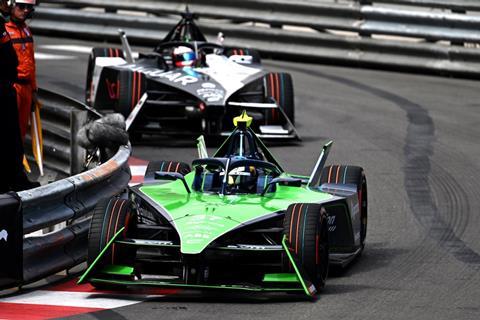
During the race, content from up to 13 vehicles can be shown live at any one time. “So, if we know there’s a battle going on, Tim’s team will tell the onboard camera team and the live camera footage is available for them. We don’t do like Formula 1 would do, with all cameras live all the time. The way our technology works, because we are in cities, the frequency bands are very limited in terms of bandwidth. In Formula 1 or MotoGP, they are very different technologies where it’s no problem for coverage. Here it’s just super-hard to do that on a quality basis. But we get all the footage back after the race, so it’s ingested within hours and available for anyone to do whatever they want with it.”
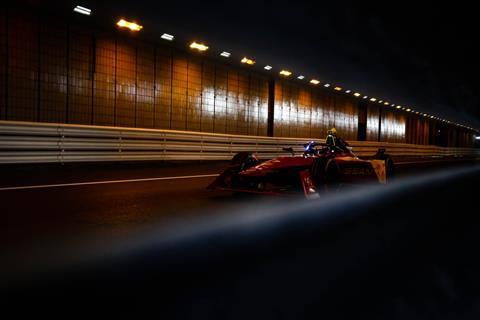
On top of the camera and remote production innovations, Ernst’s team has been using more analytical data to support Tim’s team to make decisions about what they are going to show, as well as explain to Formula E fans why things are happening or why things might happen.
“There is a massive amount of development and computation happening on these cars – the drivers being told by the car what the energy levels are, if they are using too much or too little energy, and so on, and we want to bring what they’re doing in the garage and the teams into the broadcast to make people understand how hard it is to drive these cars,” explains Ernst. “They are driving power plants – it’s a massively complex environment these drivers and teams need to work with, and that’s a story that’s very interesting. We try not to dumb it down, but just bring over the spirit of how complicated something like this is.”
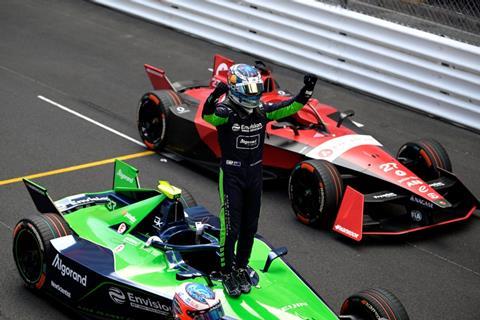
Overhauling sports coverage
Tim Glass is a relatively recent recruit for Formula E, having moved over from Sky Sports where he was senior producer on Sky F1. He tells me: “It was clear there was big investment made by Formula E to get behind the broadcast and build on the success of the previous eight years.” Since he joined Formula E less than a year ago, “there are more cameras and more of everything really to try to step up the coverage.”
Glass also singles out content created by Formula E outside of the live sports coverage as an important factor in driving awareness and building the fan base for the races. “We’ve done six episodes this year in our behind-the-scenes Unplugged series. The teams work with us really closely to give access to those ‘helmet-off’ moments and try and open the drivers up to the fans. I think that’s growing and something we’re working on to improve, because if you want to transcend the Formula E fan, you’ve got to get the people invested in the drivers.”
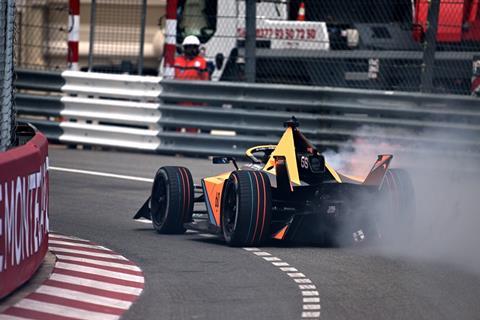
Comparing the motorsport he was previously focused on to where he is now, Glass says: “Formula 1 is amazing, but in Formula E you don’t have the lulls in racing that you get in Formula 1. With Formula E, your Championship leader might be back in ninth on the grid because it’s much more competitive across the grid. This is about the pure racing and the fact that there are so many overtakes. You can’t just open the DRS (drag reduction system) and fly past somebody on the straight. In terms of the competitiveness on the track, it’s much more exciting than Formula 1.”
Broadcast Sport watched the race live in Monaco and the next day had to leave the sun-kissed spotless scenery of Monaco to return to a cold, overcast UK where a few days later we caught up with technology consultant Dan Cherowbrier. He played a key role in the development of the remote production setup, working alongside Ernst and Glass.
“It was a big and complex operation – we first started looking at how to do it in 2020, pre-pandemic. Covid played a major part in changing a lot of peoples’ thoughts and perceptions about remote production and drove suppliers’ innovations. Formula E had learnt a lot about what it needed, and suppliers had learnt a lot about how to deliver it,” says Cherowbrier.
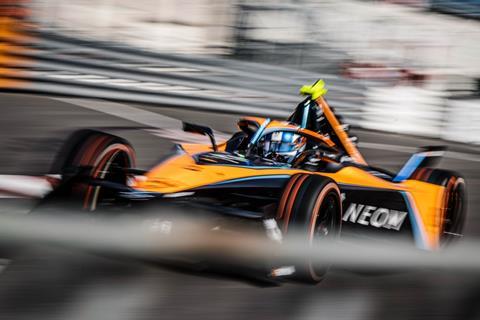
“There are the obvious benefits about delivering sustainability, less freight, less crew travel etc, but the working environment in the remote facility was a surprise benefit for Formula E and its production teams too.
“Working in a well-built permanent facility with carpets, proper desks and even windows produces much higher quality content than in the inevitably difficult environment of an OB site which has to be rebuilt every week. The access to production and technical talent in a remote facility is also much greater than the limited pool that are able to travel.”
Added to this, Cherowbrier says the much smaller footprint of the on-site facility means it can be a lot closer to the action.
The connectivity from the race to the remote production hub utilises ultra-low latency HEVC encode and file acceleration to get all the live cameras and content into just over 2Gbit/s of capacity. That 2Gbit/s is transported over two internet connections provided by connectivity partner Tata.
“The infrastructure is internet-based connectivity whereas traditionally events such as these would go for a lease line, which takes a longer time to get hold of, is very expensive and has a higher latency,” explains Cherowbrier. “Eric pushed very early on to have the last mile provided over internet as it provides flexibility in where the Championship can go – it keeps latency down and when operating in changing locations it is much easier to source, putting less risk on the event.”
The next Formula E E-Prix takes place in Portland on 24 June.







No comments yet